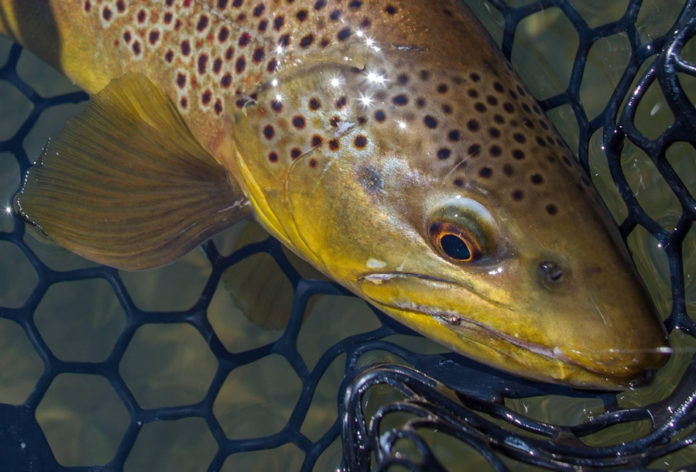Written by: Evan Jones
Photo courtesy Geri Meyer, Driftless Angler
We’ve all experienced it: sometimes the trout just stop biting. Maybe they were active earlier in the day and are resting now; or they’re focused on a different food source; or maybe they’ve moved to an entirely different location. The only certainty is, you’ve made enough fishless casts in a row that it’s time to make a change. Are you better off buckling down and using a more technical approach, or packing up and switching locations? Sometimes it’s hard to know which option is best, and it’s easy to waste precious time waffling between the two. We asked our panel of experts how they decide when to stick and when to move while trout fishing, here’s what they advise:
Tim Linehan, Linehan Outfitting Co. (Troy, Montana):
If the bite goes south in a significant way, the first thing I do is try to decide why. Knowing why trout have stopped feeding helps to decide whether to change tactics or move on.
It’s critically important to keep in mind that one section of a river may have active fish, while half a mile downstream there are no feeding fish to be seen.bFor instance, if the hatch is over in a smooth dry-fly run, I’d likely move to a different water type better-suited for nymphing or searching with attractor patterns.
If fish are actively feeding, there’s no reason to move on. If I see active fish, I’m all-in and will generally try to work it out.
Kaitlin Barnhart, co-founder of The Mayfly Project (Coeur d’Alene, Idaho):
I’m well known for moving up a river quickly to fish as much water as I can in a day, but I have learned there are seasons and situations that require slowing down and fishing a stretch of river patiently.
During summer, spring, and fall, I decide whether to buckle down and fish a section, or give up and move on, based on examining the food available for the fish, and then fishing various depths accordingly. If I see a hatch taking off and no fish eating on the surface, I’ll switch to an emerger to try fishing subsurface. I’ll continue to change the depths and size of flies I’m drifting, farther down into the water column, to see if I can find where they are feeding. After I’ve matched the hatch, tried various depths and drifts, and still haven’t produced fish, I’ll move on upriver.
In the colder months, I know fish will hold in deeper holes, troughs, and places where they can slurp up food without much effort. When I find those sections of river, I know I need to stop and spend more time there than I’m normally comfortable with.
If the question is knowing when to give up and call it a day when it’s just not working out, the answer is never; a day on the river is good for the soul, even if the net remains empty.
Joe Demalderis, Cross Current Guide Service (Milford, Pennsylvania):
It’s been said that the definition of insanity is doing the same thing over and over while expecting different results, yet that is exactly what many of us do when fly fishing. I’m not one to quickly change flies, but I do often change techniques or presentations when what was working no longer does. The change-up can also be where I’m fishing. When fishing from a boat, it’s easy to change locations without the commitment of hiking out and driving somewhere else, but moving is important even if you’re on foot.
In most stream and river situations during most of the season, the fish aren’t migrating, so a short shift in location, like from the pool to the riffle, is all it might take to get the line tight again. Changing my technique from dry flies to nymphing can also help to correct the situation. Maybe conditions changed. Clouds can quickly turn to sunshine, driving dry-fly risers down to become subsurface emerger feeders. Now, swinging a wet fly might be the answer.
In the end, it’s simple: do something else. Change location, change technique, or change flies. Change can be good. There’s no “always-do” this or that, or a “never-do” this or that. Going home or taking a nap on the bank is always an option too; fly fishing is supposed to be fun.
Patrick Fulkrod, The South Holston River Company (Bristol, Virginia):
On a day when conditions change from good to bad, knowing when to make “the adjustment” can be a tricky but critical thing. I find myself too often refusing to give up a go-to rig, but if my initial strategy is not productive after 30-45 mins, then a change needs to happen.
Initially, I like to make observations on weather and flows, since the two can often go hand-in-hand. If the sun pops out and/or the flows reduce, I will go smaller on tippet–this one is easy. Another trick is to use smaller flies. If it rains or becomes cloudy, I may switch to a more prospecting-type fly pattern such as a worm, flashback nymph, and the like. If the flows increase and/or there is a change in water clarity, I will take a more aggressive approach, such as using a streamer.
Knowing the entomology of your fishery can also be a huge key to success. I often will use a seine net to search for bugs in the water column, so I can better imitate the naturals. Another great tip is to watch the feeding habits of your fish: if the trout breaks the water surface aggressively, it will often be after a caddis or midge, since these insects hatch off the water very erratically. Mayfly takes tend to be more sip-like given the smooth flight patterns of a fresh dun.
Basically, it all comes down to keen observation: that’s the magic term I go by while on the water. Being dynamic in your approach to fly fishing can be very rewarding. But when all else fails, also remember that there are times when the fish just do not feed.
Chuck Hawkins, Hawkins Outfitters (Traverse City, Michigan):
As a guide, we are always buckling down if the fish aren’t biting. In Northern Michigan on most of our trout waters, we are unable to effectively nymph due to the amount of downed wood. That leaves us with primarily dry flies and/or streamers, which can make our resident trout fishing difficult at times. Here is how I buckle down:
Depending on angler ability and the water and weather conditions, streamers are a go-to method on my boat. When choosing streamers, I have various sizes, colors and profiles that I sift through looking for a positive response. I also have a lot of history on these waters, so I certainly have some favorites. Several are in the Orvis catalog like the Nutcracker, Triple Double and the Little Rascal. All of these flies are carried in normal sizes, such as 4 and 6, but also in much smaller sizes that can be used to attract attention. Sometimes a size 12 gets bit when nothing happens on the larger sizes.
It can also be important to pay attention to profile, along with size and color. Some days it’s a sculpin/gobie profile and other days it’s a baitfish. I’m always paying attention to size, color, and profile when looking for the answer.
Every now and then, twitch bugs are the answer. A Girdle Bug or Wet Skunk fished on a floating line can sometimes attract bites even when bugs aren’t hatching. We cast them into likely-looking areas, let them sink, twitch them back up, and then repeat. This method allows you to really put your fly in their face! We fish these in black, brown, olive, and brown/gold with white rubber legs.
Geri Meyer, Driftless Angler (Viroqua, Wisconsin):
When the trout stop biting in the Driftless area of Wisconsin, we have plenty of options, and lots of water where we can relocate. So I typically choose to hit the bricks only as a last resort. Here’s what I typically try before getting to that point:
1. The very first change I make when fish aren’t biting is to put movement into my fly. I’ll jig, I’ll twitch, and I’ll skitter. Fish can be very responsive to moving flies, especially in the Driftless Area.
2. My next change will be size. If I’m feeling pretty good with my fly choice but fish still aren’t responding favorably, I will almost always go smaller.
3. If a size change doesn’t work, I will try a color change, especially in warmer months when I’m fishing terrestrials. Going from a natural Chernobyl to a bright royal purple one will often get a fish looking, while the reverse is often true in the cooler months of fall, when fish prefer more natural colors.
4. Next up is a fly pattern change, usually between caddisfly, mayfly, scud, and midge. I also try to change profiles from larger to smaller (for example, Caddis/Hare’s Ear to Scud to Zebra Midge).
5. Next I’ll go down in tippet size, or put on camo tippet.
6. One of my last resorts is to put on a leech or streamer, or something generally big and ugly. I will often try to put on a fly that I think the fish haven’t seen before. I usually start with a slow almost dead drift with some occasional tics, then put some strips into it later on.
Remember that if fish are fussy, you’re probably not going to get a lot of shots, so make sure that your first cast is your best, and always be ready.
If all of the above fails, then I’ll move to a different spot. But some days, when the fish are done with me, I’ll just sit down and listen to the water, look around and try to be grateful. Always remember, it’s just fishing, so have fun!
Credit: Source link































